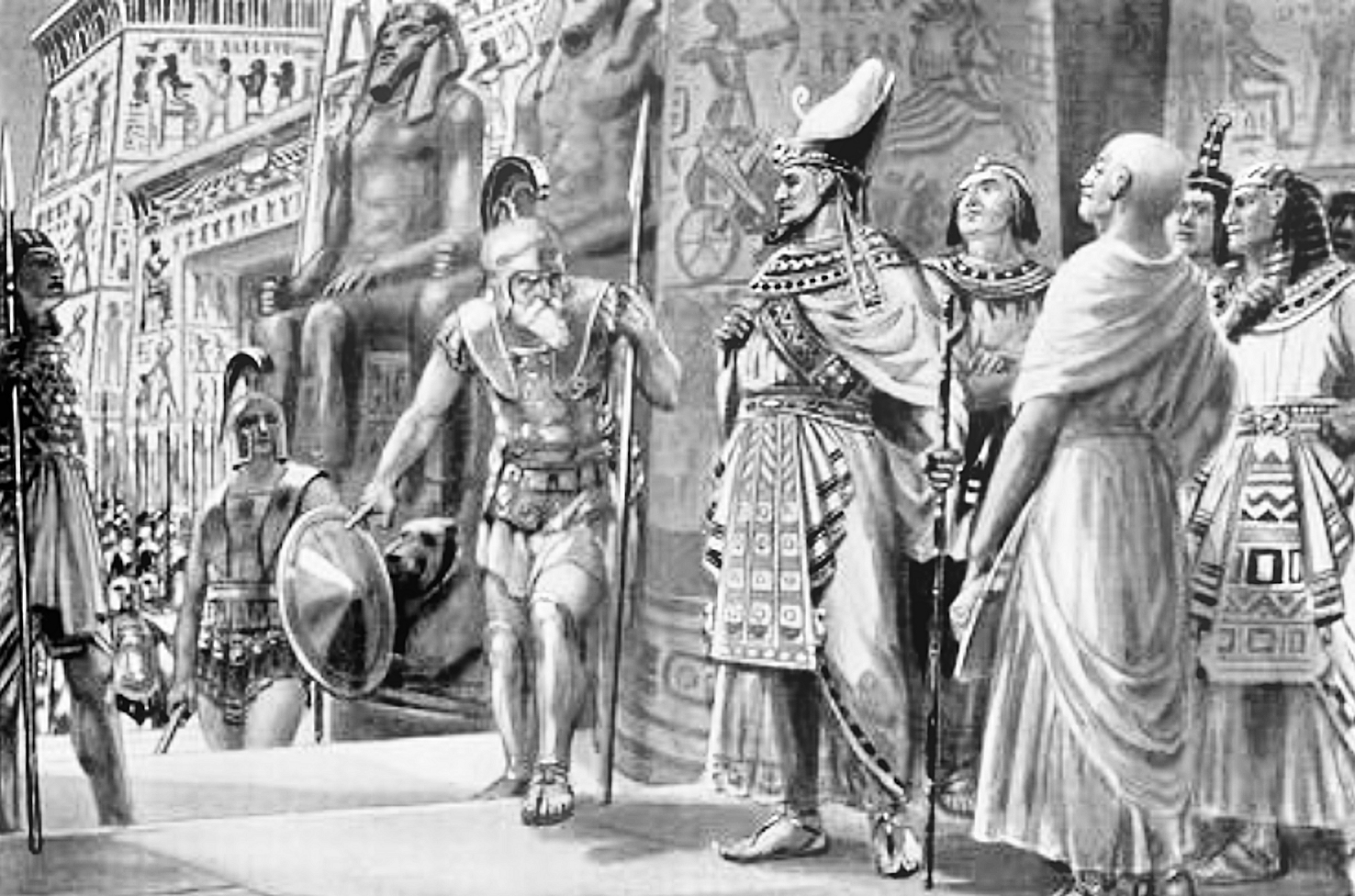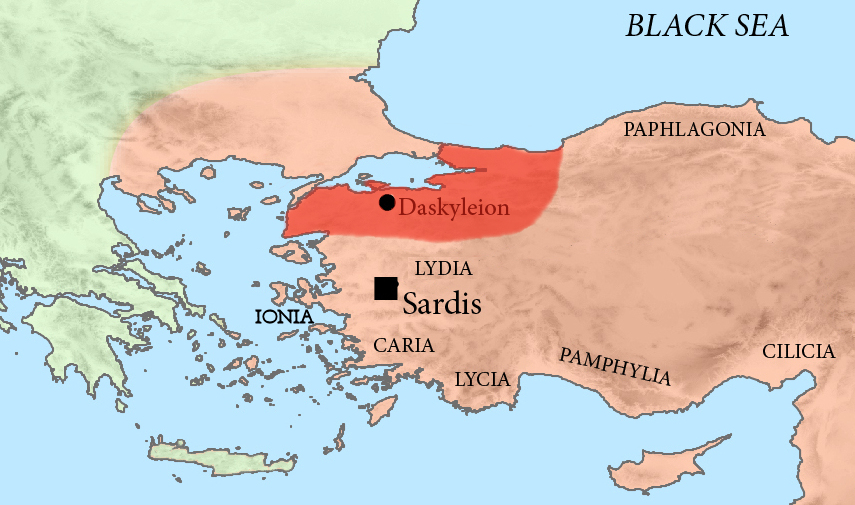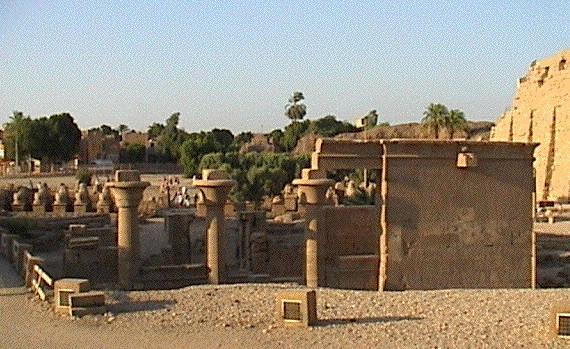|
Chabrias
Chabrias ( el, Χαβρίας; bef. 420–357 BC) was an Athenian general active in the first half of the 4th century BC. During his career he was involved in several battles, both on land and sea. The orator Demosthenes described him as one of the most successful commanders Athens ever had:To sum up the whole: he is the only general who never lost a single city or post or ship or soldier, when he commanded you: none of your enemies has any trophy over you and him, while you have many over many enemies under his command. Family Little is known of Chabrias' background, except that his father's name was Ktesippos and was rich enough to be subject to the liturgies, having been a trierarch in 377–6 BC. He is known to have had one other son, who was also named Ktesippos. Career Corinthian War (395–387 BC) Chabrias’s first appearance in the historical record was his appointment as ''strategos'' (general) in 390–89 during the Corinthian War (so called because most of t ... [...More Info...] [...Related Items...] OR: [Wikipedia] [Google] [Baidu] |
Theban Sacred Band
The Sacred Band of Thebes (Ancient Greek: , ''Hierós Lókhos'') was a troop of select soldiers, consisting of 150 pairs of male lovers which formed the elite force of the Theban army in the 4th century BC, ending Spartan domination. Its predominance began with its crucial role in the Battle of Leuctra in 371 BC. It was annihilated by Philip II of Macedon in the Battle of Chaeronea in 338 BC. Formation The earliest surviving record of the Sacred Band by name was in 324 BC, in the oration ''Against Demosthenes'' by the Athenian logographer Dinarchus. He mentions the Sacred Band as being led by the general Pelopidas and, alongside Epaminondas who commanded the army of Thebes (Boeotia), were responsible for the defeat of the Spartans at the decisive Battle of Leuctra (371 BC). Plutarch (46–120 AD), a native of the village of Chaeronea, is the source of the most substantial surviving account of the Sacred Band. He records that the Sacred Band was originally formed by the ... [...More Info...] [...Related Items...] OR: [Wikipedia] [Google] [Baidu] |
Boeotian War
The Boeotian War broke out in 378 BC as the result of a revolt in Thebes against Sparta. The war saw Thebes become dominant in the Greek World at the expense of Sparta. However, by the end of the war Thebes’ greatest leaders, Pelopidas and Epaminondas, were both dead and Thebes power already waning, allowing for the Rise of Macedon. Background After the end of the Corinthian War, which had seen many of Sparta’s allies abandon her, Sparta began reconstructing its hegemony and punishing many disloyal allies. In 385 BC Sparta attacked Mantinea claiming they had failed to fulfil their allied obligations. When Sparta took the city they split it into four settlements, as that was what it had used to be. In the north the city of Olynthus grew in power and violated the terms agreed upon at the end of the Corinthian War. Because of this Sparta sent an army against the city under the command of Phoebidas. When the army was in Boeotia around 383 or 382 BC, Leontiades, who was lead ... [...More Info...] [...Related Items...] OR: [Wikipedia] [Google] [Baidu] |
Teos Of Egypt
Djedhor, better known as Teos ( grc, Τέως) or Tachos ( grc, Τάχως), was an ancient Egyptian pharaoh of the 30th Dynasty. Biography A son of his predecessor Nectanebo I, Teos was his co-regent for three years before ascending to the throne in 361–60 BCE. Expedition against Persians Nectanebo's success in the Nile Delta against the invading Persian armies in 374–73 BCE encouraged Teos to start to plan a military expedition into Palestine and Phoenicia, which were territories controlled by the Persians. Taking advantage of a moment of weakness for the Achaemenid Empire due to riots in some satrapies in Asia Minor, Teos sought assistance from both the octogenarian king Agesilaus II of Sparta and the Athenian general Chabrias, including a number of mercenaries and 200 triremes, from Greece. However, to finance such an expedition, Teos had to impose new taxes and to expropriate the goods of the temples, destroying the delicate balance artfully established by his father N ... [...More Info...] [...Related Items...] OR: [Wikipedia] [Google] [Baidu] |
Artaxerxes II Of Persia
Arses ( grc-gre, Ἄρσης; 445 – 359/8 BC), known by his regnal name Artaxerxes II ( peo, 𐎠𐎼𐎫𐎧𐏁𐏂 ; grc-gre, Ἀρταξέρξης), was King of Kings of the Achaemenid Empire from 405/4 BC to 358 BC. He was the son and successor of Darius II () and his mother was Parysatis. Soon after his accession, Artaxerxes II faced opposition from his younger brother Cyrus the Younger, who assembled an army composing of troops from his Lydia, Lydian and Ionians, Ionian satrapies as well as Greek mercenaries in his bid for the throne. The forces of the brothers clashed at Battle of Cunaxa, Cunaxa in 401 BC, which resulted in the defeat and death of Cyrus. Following this, Artaxerxes II had to contend with several other revolts; a revolt by Evagoras I () in Cyprus between 391–380 BC, by the Phoenicians in , and most importantly, the revolts by the western satraps (known as the Great Satraps' Revolt) in the 360s and 350s BC, led by distinguished figures such as Datames, A ... [...More Info...] [...Related Items...] OR: [Wikipedia] [Google] [Baidu] |
Nectanebo I
Nectanebo I (Egyptian: ; grc-gre, Νεκτάνεβις ; died 361/60 BCE) was an ancient Egyptian pharaoh, founder of the last native dynasty of Egypt, the 30th. Name Nectanebo's Egyptian personal name was Nḫt-nb.f, which means "the strong one of his lord". Greek sources rendered the name as (). The writings of Manetho which have been preserved by George Syncellus spell it (), but this is probably only based on a phonetic approximation due to iotacism. Although convention in English assigns identical names to him and his grandson, Nectanebo II, the two in fact had different names. Reign Accession and family Nectanebo was an army general from Sebennytos, son of an important military officer named Djedhor and of a lady whose name is only partially recorded, ..u. A stele found at Hermopolis provides some evidence that he came to power by overthrowing, and possibly putting to death, the last pharaoh of the 29th Dynasty Nepherites II. It has been suggested that Nectanebo w ... [...More Info...] [...Related Items...] OR: [Wikipedia] [Google] [Baidu] |
Corinthian War
The Corinthian War (395–387 BC) was a conflict in ancient Greece which pitted Sparta against a coalition of city-states comprising Thebes, Athens, Corinth and Argos, backed by the Achaemenid Empire. The war was caused by dissatisfaction with Spartan imperialism in the aftermath of the Peloponnesian War (431–404 BC), both from Athens, the defeated side in that conflict, and from Sparta's former allies, Corinth and Thebes, who had not been properly rewarded. Taking advantage of the fact that the Spartan king Agesilaus II was away campaigning in Asia against the Achaemenid Empire, Thebes, Athens, Corinth and Argos forged an alliance in 395 BC with the goal of ending Spartan hegemony over Greece; the allies' war council was located in Corinth, which gave its name to the war. By the end of the conflict, the allies had failed to end Spartan hegemony over Greece, although Sparta was durably weakened by the war. At first, the Spartans achieved several successes in pitched battles ... [...More Info...] [...Related Items...] OR: [Wikipedia] [Google] [Baidu] |
Agesilaus II
Agesilaus II (; grc-gre, Ἀγησίλαος ; c. 442 – 358 BC) was king of Sparta from c. 399 to 358 BC. Generally considered the most important king in the history of Sparta, Agesilaus was the main actor during the period of Spartan hegemony that followed the Peloponnesian War (431–404 BC). Although brave in combat, Agesilaus lacked the diplomatic skills to preserve Sparta's position, especially against the rising power of Thebes, which reduced Sparta to a secondary power after its victory at Leuctra in 371 BC. Despite the traditional secrecy fostered by the Spartiates, the reign of Agesilaus is particularly well-known thanks to the works of his friend Xenophon, who wrote a large history of Greece (the '' Hellenica'') covering the years 411 to 362 BC, therefore extensively dealing with Agesilaus' rule. Xenophon furthermore composed a panegyric biography of his friend, perhaps to clean his memory from the criticisms voiced against him. Another historical tradition—much ... [...More Info...] [...Related Items...] OR: [Wikipedia] [Google] [Baidu] |
Pharnabazus II
Pharnabazus II (Old Iranian: ''Farnabāzu'', grc-gre, Φαρνάβαζος ; ruled 413-374 BC) was a Persian soldier and statesman, and Satrap of Hellespontine Phrygia. He was the son of Pharnaces II of Phrygia and grandson of Pharnabazus I, and great-grandson of Artabazus I. He and his male ancestors, forming the Pharnacid dynasty, had governed the satrapy of Hellespontine Phrygia from its headquarters at Dascylium since 478 BC. He married Apama, daughter of Artaxerxes II of Persia, and their son Artabazus also became a satrap of Phrygia. According to some accounts, his granddaughter Barsine may have become Alexander the Great's concubine. According to research by Theodor Nöldeke, he was descended from Otanes, one of the associates of Darius in the murder of Smerdis. Satrap of Hellespontine Phrygia War with Sparta against Athens (c.413-404 BC) Athens was the dominant power in the Aegean in the 5th century BC, following the Greeks' victories over the Achaemenids in th ... [...More Info...] [...Related Items...] OR: [Wikipedia] [Google] [Baidu] |
Agesilaus
Agesilaus II (; grc-gre, Ἀγησίλαος ; c. 442 – 358 BC) was king of Sparta from c. 399 to 358 BC. Generally considered the most important king in the history of Sparta, Agesilaus was the main actor during the period of Spartan hegemony that followed the Peloponnesian War (431–404 BC). Although brave in combat, Agesilaus lacked the diplomatic skills to preserve Sparta's position, especially against the rising power of Thebes, which reduced Sparta to a secondary power after its victory at Leuctra in 371 BC. Despite the traditional secrecy fostered by the Spartiates, the reign of Agesilaus is particularly well-known thanks to the works of his friend Xenophon, who wrote a large history of Greece (the ''Hellenica'') covering the years 411 to 362 BC, therefore extensively dealing with Agesilaus' rule. Xenophon furthermore composed a panegyric biography of his friend, perhaps to clean his memory from the criticisms voiced against him. Another historical tradition—much mo ... [...More Info...] [...Related Items...] OR: [Wikipedia] [Google] [Baidu] |
Hakor
Hakor or Hagar, also known by the hellenized forms Achoris or Hakoris, was an ancient Egyptian pharaoh of the 29th Dynasty. His reign marks the apex of this feeble and short-lived dynasty, having ruled for 13 years – more than half of its entire duration. Reign Struggle for the accession Hakor's accession and relationships with his predecessor Nepherites I were long debated. After Nepherites' death a dynastic struggle did seem to have occurred, and the throne was claimed by two or maybe three pretenders: Hakor, Psammuthes, and possibly a phantom figure called Muthis who was only mentioned in Eusebius' epitome of Manetho's ''Aegyptiaca''. As a result, Hakor was alternately considered Nepherites' legitimate successor or an unrelated usurper. In 1986, John D. Ray suggested that Hakor was Nepherites' heir, who ruled undisturbed until his Year 2 when he was deposed by Psammuthes. After another year, Hakor managed to retake his legitimate throne by overthrowing the usurper, and cont ... [...More Info...] [...Related Items...] OR: [Wikipedia] [Google] [Baidu] |
Chios
Chios (; el, Χίος, Chíos , traditionally known as Scio in English) is the fifth largest Greek island, situated in the northern Aegean Sea. The island is separated from Turkey by the Chios Strait. Chios is notable for its exports of mastic gum and its nickname is "the Mastic Island". Tourist attractions include its medieval villages and the 11th-century monastery of Nea Moni, a UNESCO World Heritage Site. Administratively, the island forms a separate municipality within the Chios regional unit, which is part of the North Aegean region. The principal town of the island and seat of the municipality is Chios. Locals refer to Chios town as ''Chora'' ( literally means land or country, but usually refers to the capital or a settlement at the highest point of a Greek island). The island was also the site of the Chios massacre, in which thousands of Greeks on the island were massacred, expelled, and enslaved by Ottoman troops during the Greek War of Independence in 1822. Geogra ... [...More Info...] [...Related Items...] OR: [Wikipedia] [Google] [Baidu] |
Aixone
Aexone or Aixone ( grc, Αἰξωνή) was a deme of ancient Attica situated on the coast south of Halimus. Aixone, along with neighbouring Halai Aixonidai, belonged to the Kekropis tribe. Aexone was celebrated for its fisheries. The site of Aexone is located at the modern Glyfada Glyfada ( el, Γλυφάδα, ) is a suburb in South Athens located in the Athens Riviera along the Athens coast. It is situated in the southern parts of the Athens' Urban Area. The area stretches from the foot of the Hymettus mountain to the S .... References Populated places in ancient Attica Former populated places in Greece Demoi {{AncientAttica-geo-stub ... [...More Info...] [...Related Items...] OR: [Wikipedia] [Google] [Baidu] |



.jpg)


